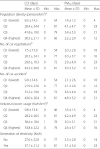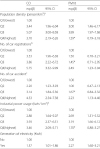1. Ministry of Environment. 2017 white paper of environment. 2017. Sejongsi: Ministry of Environment.
2. Cai Y, Hansell AL, Blangiardo M, Burton PR; BioShaRe, de Hoogh K, et al. Long-term exposure to road traffic noise, ambient air pollution, and cardiovascular risk factors in the HUNT and lifelines cohorts. Eur Heart J. 2017; 38:2290–2296. DOI:
10.1093/eurheartj/ehx263. PMID:
28575405.

3. Cascio WE. Proposed pathophysiologic framework to explain some excess cardiovascular death associated with ambient air particle pollution: insights for public health translation. Biochim Biophys Acta. 2016; 1860:2869–2879. DOI:
10.1016/j.bbagen.2016.07.016. PMID:
27451957.

4. DeFranco E, Moravec W, Xu F, Hall E, Hossain M, Haynes EN, et al. Exposure to airborne particulate matter during pregnancy is associated with preterm birth: a population-based cohort study. Environ Health. 2016; 15:6. DOI:
10.1186/s12940-016-0094-3. PMID:
26768419.

5. Furuyama A, Kanno S, Kobayashi T, Hirano S. Extrapulmonary translocation of intratracheally instilled fine and ultrafine particles via direct and alveolar macrophage-associated routes. Arch Toxicol. 2009; 83:429–437. DOI:
10.1007/s00204-008-0371-1. PMID:
18953527.

6. Gauderman WJ, Urman R, Avol E, Berhane K, McConnell R, Rappaport E, et al. Association of improved air quality with lung development in children. N Engl J Med. 2015; 372:905–913. DOI:
10.1056/NEJMoa1414123. PMID:
25738666.

7. Goldberg MS, Labreche F, Weichenthal S, Lavigne E, Valois MF, Hatzopoulou M, et al. The association between the incidence of postmenopausal breast cancer and concentrations at street-level of nitrogen dioxide and ultrafine particles. Environ Res. 2017; 158:7–15. DOI:
10.1016/j.envres.2017.05.038. PMID:
28595043.

8. Int Panis L, Provost EB, Cox B, Louwies T, Laeremans M, Standaert A, et al. Short-term air pollution exposure decreases lung function: a repeated measures study in healthy adults. Environ Health. 2017; 16:60. DOI:
10.1186/s12940-017-0271-z. PMID:
28615020.

9. Oberdorster G, Sharp Z, Atudorei V, Elder A, Gelein R, Kreyling W, et al. Translocation of inhaled ultrafine particles to the brain. Inhal Toxicol. 2004; 16:437–445. DOI:
10.1080/08958370490439597. PMID:
15204759.
10. Raaschou-Nielsen O, Pedersen M, Stafoggia M, Weinmayr G, Andersen ZJ, Galassi C, et al. Outdoor air pollution and risk for kidney parenchyma cancer in 14 European cohorts. Int J Cancer. 2017; 140:1528–1537. DOI:
10.1002/ijc.30587. PMID:
28006861.

11. Talbott EO, Arena VC, Rager JR, Clougherty JE, Michanowicz DR, Sharma RK, et al. Fine particulate matter and the risk of autism spectrum disorder. Environ Res. 2015; 140:414–420. DOI:
10.1016/j.envres.2015.04.021. PMID:
25957837.

12. National Institute of Environment Research. KORUS-AQ rapid science synthesis report. 2017. Incheon: National Institute of Environmental Research.
13. Ehrlich C, Noll G, Kalkoff W, Baumbach G, Dreiseidler A. PM
10, PM
2.5 and PM
1.0—emissions from industrial plants—results from measurement programmes in Germany. Atmos Environ. 2007; 41:6236–6254. DOI:
10.1016/j.atmosenv.2007.03.059.
14. Li KC, Hwang I. Characteristics of PM
2.5 in Gyeongsan using statistical analysis. J Korean Soc Atmos Environ. 2015; 31:520–529. DOI:
10.5572/KOSAE.2015.31.6.520.

15. Srimuruganandam B, Shiva Nagendra SM. Source characterization of PM
10 and PM
2.5 mass using a chemical mass balance model at urban roadside. Sci Total Environ. 2012; 433:8–19. DOI:
10.1016/j.scitotenv.2012.05.082. PMID:
22766423.
16. Wu D, Wang Z, Chen J, Kong S, Fu X, Deng H, et al. Polycyclic aromatic hydrocarbons (PAHs) in atmospheric PM
2.5 and PM
10 at a coal-based industrial city: implication for PAH control at industrial agglomeration regions, China. Atmos Res. 2014; 149:217–229. DOI:
10.1016/j.atmosres.2014.06.012.
17. Cichowicz R, Wielgosinski G, Fetter W. Dispersion of atmospheric air pollution in summer and winter season. Environ Monit Assess. 2017; 189:605. DOI:
10.1007/s10661-017-6319-2. PMID:
29103077.

18. Ahmed E, Kim KH, Shon ZH, Song SK. Long-term trend of airborne particulate matter in Seoul, Korea from 2004 to 2013. Atmos Environ. 2015; 101:125–133. DOI:
10.1016/j.atmosenv.2014.11.024.

19. Kim H, Zhang Q, Bae G-N, Kim JY, Lee SB. Sources and atmospheric processing of winter aerosols in Seoul, Korea: insights from real-time measurements using a high-resolution aerosol mass spectrometer. Atmos Chem Phys. 2017; 17:2009–2033. DOI:
10.5194/acp-17-2009-2017.
20. Kim HS, Huh JB, Hopke PK, Holsen TM, Yi SM. Characteristics of the major chemical constituents of PM
2.5 and smog events in Seoul, Korea in 2003 and 2004. Atmos Environ. 2007; 41:6762–6770. DOI:
10.1016/j.atmosenv.2007.04.060.
24. Park B. Predicting the traffic accident and volume using simultaneous equations. J Institute Constr Technology. 2014; 33(1):1–6.
27. Ministry of the Interior and Safety. Public data portal. 2016.
http://www.data.go.kr. Accessed 15 Aug 2018.
30. Liu SV, Chen FL, Xue J. Evaluation of traffic density parameters as an Indicator of vehicle emission-related near-road air pollution: a case study with NEXUS measurement data on black carbon. Int J Environ Res Public Health. 2017; 14:12.

31. Environmental Proctctions Agency. Population density traffic density and nox emission air pollution density in major metropolitan areas of the United States. 2010.
33. Commission for Environmental Cooperation. North American power plant air emissions. Montreal(Quebec) Commission for environmental cooperation; 2011.







 PDF
PDF Citation
Citation Print
Print



 XML Download
XML Download